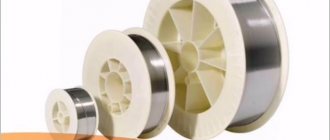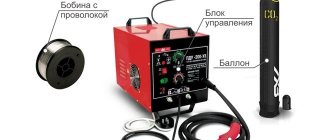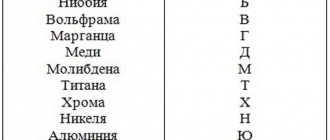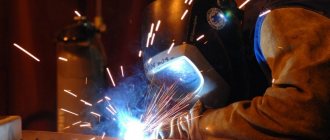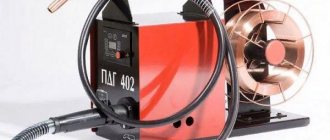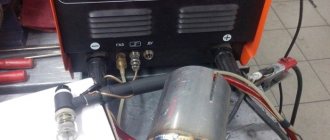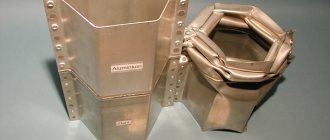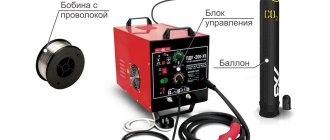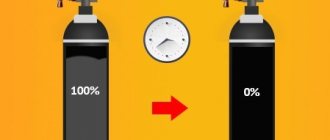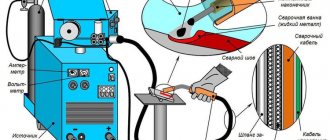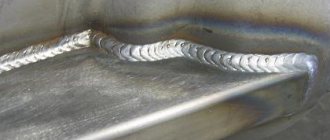Material that does not rust
Various alloying additives are added to low-carbon steel: chromium - at least 12%, nickel, etc. Chromium, when interacting with oxygen from the air, forms a very thin oxide film on the surface, which prevents the rusting process and the action of a chemically aggressive environment. The surface anti-corrosion layer is restored if damaged. Stainless steel has its own characteristics:
- Low thermal conductivity prevents heat removal from the welding site. As a result, overheating and burning of the metal occurs, and alloying elements burn out.
- Low melting point reduces energy costs.
- Low electrical conductivity leads to a decrease in voltage on the metal of the workpiece, which causes overheating and the formation of burns, especially on thin parts
- Large thermal expansion deforms parts when heated.
A material with such properties is difficult to weld. There are several methods, one of which is welding using a semi-automatic machine. A beginner can learn how to semi-automatically cook stainless steel on the website mrmetall.ru.
Which gas to choose
To protect the weld pool from the negative influence of air, gas is used. It improves the burning of the wire and its adhesion to the workpiece without reacting with the molten metal.
There are two methods: MIG – welding with protection with inert gases: argon, helium; MAG – with active gases: nitrogen, oxygen, carbon monoxide.
The main gases used are argon (Ar), carbon dioxide (CO2) - carbon dioxide, nitrogen (N2) and their mixtures.
In a carbon dioxide environment, semi-automatic welding of stainless steel is a frequently encountered option, as it is more economically accessible. In this case, the seam turns out to be clumsy due to the strong splashing of metal.
When using argon, you get a reliable seam that has a beautiful shape. The high cost of gas requires its use for products where the appearance of the connection is important. Semi-automatic welding of stainless steel with argon is most used in industry.
Each gas in its pure form has positive and negative qualities. Therefore, for a more efficient process, gas mixtures in various proportions are used. Based on the complexity of the work, the required result and material costs, one or another gas mixture is chosen.
The most commonly used composition is Ar+CO2 in the proportions of 98% to 2%, 95% to 5%, respectively. Without increased requirements for the type of seam, an increase in carbon dioxide up to 32% is allowed. The percentage depends on the thickness of the material, its type and other parameters. Welding stainless steel in such a protective mixture promotes good spreading of the molten metal and improves the structure of the seam.
Sometimes 1-5% oxygen is added to argon - Ar+O2 . This helps to reduce the porosity of the treated surface and small-droplet transfer of metal, and stabilizes the arc.
Advantages
- No additional use of flux or its calculation in a certain proportion is required;
- The welding process becomes better and the percentage of defects decreases;
- The use of wire becomes simpler and more efficient;
- Many negative nuances of difficult-to-weld metals fade into the background thanks to correctly selected additional consumables;
- The connection speeds up, since welding with flux-cored wire allows it to come into contact with the base metal faster;
- For automatic devices, this is one of the best options, which guarantees a more reliable connection;
- There is no risk that any extra elements will get into the molten seam with the flux.
Wire selection
When welding, the wire is both an additive and, together with the molten metal, fills the seam. Two types are used: powder and solid with a very low carbon content and high silicon content, resistant to an oxidizing environment.
The diameter varies from 0.13 to 6-10mm. For household use, wire with a cross-section of 0.6 and 0.8 mm is usually taken; for production, where they work with powerful semi-automatic systems, wire with a cross-section of over 1.0 mm is used.
To weld stainless steel semi-automatically without gas, use flux-cored (self-shielding) wire. It is a thin steel tube filled with flux. When the top layer melts, the flux is released and also protects the welding zone from oxidation. A lot of slag is formed that must be removed.
Solid wire is used to carry out the process in a gas environment and submerged arc, and it must be identical to the metal being processed, i.e. made of stainless steel. It is better to take wire with a slightly higher content of alloying elements, due to their burnout at high temperatures.
Some brands of welding wire:
- 0.8x20n9g7t – contains chromium, nickel and manganese;
- 0.6x19n9t – high quality, corrosion resistant;
- 0.4x19n11m3 – chrome-nickel with the addition of silicon and molybdenum for resistance to intercrystalline corrosion.
To reduce the formation of splashes from molten metal, a wire of smaller diameter than the electrode is used. The seam is neat, but at the same time its consumption increases.
Some devices are equipped with a cable hose, inside which wire, gas, and current pass separately from each other to deliver it to the welding zone - the so-called welding hose.
What wire should I use to weld stainless steel semi-automatically?
This article will provide all the basic information about stainless steel welding wire. You will learn the features of its marking, the requirements that a quality product must meet, and what you need to pay attention to when choosing.
The features of semi-automatic welding technology with wire will also be analyzed, and the current state of the market for these materials will be analyzed for the main manufacturers and their pricing policy.
Wire welding
The wire is an element that, when welding semi-automatically, takes on the functions of an electrode and transmits current to the surfaces being welded. In addition to this, the knitting wire acts as a filler material, when melted, a welding seam is formed.
Marking of stainless wire for welding
Below is a standard type of wire marking and an explanation of its meaning.
Explanation of standard welding wire markings
- Diameter of metal thread. Stainless steel threads with a diameter of 1.6 mm, 1.2 mm, 1 mm, 0.8 mm and 0.6 mm for semi-automatic welding
- Product brand.
Cell No. 2 – purpose: SV – welding, or NP – surfacing; cell No. 3 – carbon concentration in the raw material, which is indicated in hundredths of a percent. For example: CB09 is a product for welding with a carbon content of 0.09%. Cells No. 4, No. 5, No. 6 and No. 7 indicate the concentration of additional alloying impurities.
The marking features are as follows: Y - aluminum, D - Copper, T - titanium, G - manganese, C - zirconium, M - molybdenum, X - chromium, N - Nickel, S - silicon. In the cell next after the indicated letter there is a number , which indicates the concentration of a given element, but if the content of the element is within one percent, then, as a rule, the number is not given.
For example: stainless steel knitting wire for semi-automatic welding SV09N5X21T contains 0.9% carbon, 5% nickel, 21% chromium, and 1 percent titanium.
Cell No. 8 - marking in this cell is placed if the welding thread meets the increased requirements for harmful sulfur and phosphorus impurities.
Depending on the standard of the wire, two indicators can be placed in this cell: A - indicating that the product is manufactured according to high cleaning standards, AA - the principle of maximum cleaning was used in the production process, this is how the highest quality stainless steel welding wire is usually marked;
- Production technology (smelting method): Ш – electroslag smelting, VI – smelting in vacuum-induction furnaces (the most preferable option in terms of the final quality of the product), VD – smelting in vacuum-arc furnaces;
- In the case where electrodes can be made from this thread, the marking contains the indicator E;
- O – marking element highlighting copper-coated wire;
- Product compliance with the State Quality Standard.
About making wire
The current standard, according to the requirements of which stainless steel welding wire is produced, is GOST of the Russian Federation 2246-70 “Welding wire made of high-alloy, heat-resistant and corrosion-resistant steel.”
Coils of stainless wire for semi-automatic machines
Since the efficiency of semi-automatic welding directly depends on the quality of the welding wire used, this GOST puts forward strict requirements for the raw materials used to create it.
According to the requirements of GOST 2246, the presence of the following materials in the product is strictly standardized:
The amount of carbon contained in raw materials directly affects the quality of the final product.
If the carbon concentration is sufficient, which is extremely important for a welding thread, then the stainless threads will have good ductility, which has a positive effect on the ease of use in the welding process, and, at the same time, high strength and wear resistance, as a result of which wire consumption will be reduced.
- Manganese and silicon impurities.
These elements are used to deoxidize raw materials during the smelting process. The optimal concentration of manganese and silicon gives the stainless thread high resistance to abrasion, resulting in increased wear resistance and elasticity.
However, it is extremely important that phosphorus and silicon impurities are evenly dissolved in stainless steel, since accumulations of oxides in which silicon molecules can accumulate negatively affect the elasticity of the welded wire.
These elements belong to the category of harmful impurities, therefore their quantity in the raw materials for the manufacture of stainless steel products for semi-automatic welding is strictly standardized.
Stainless Welding Wire Production Process
According to the current GOST 2246, the total concentration of sulfur and phosphorus in stainless steel should not exceed 0.05%; when this norm is increased, stainless steel acquires the property of “red brittleness” - increased brittleness under the influence of high temperature, which makes it difficult to use during welding.
data-ad-client=»ca-pub-8514915293567855″ data-ad-slot=»1955705077″>
Chromium is a foreign element that enters stainless steel blanks during their smelting in blast furnaces. The presence of chromium negatively affects the strength characteristics of the final product, so manufacturers are taking various measures to reduce its concentration, which, according to GOST, should not exceed 0.1%.
The presence of nitrogen impurities in stainless steel has virtually no effect on the strength and elasticity of fresh thread. However, over time, nitrogen provokes an increase in the properties of strain aging - loss of performance characteristics of the product, such as elasticity, strength and fragility.
- The rest (non-metallic impurities).
Any non-metallic impurities in the composition of stainless thread for semi-automatic welding are defects and indicate low quality of the product.
Features of use
There are two main technologies for semi-automatic welding using stainless wire: welding using a short arc, and the pulse method. There is also jet transfer welding; this method does not necessarily require the use of gas, but flux-cored binding wire is better suited for its implementation.
Welding using a short arc (jet transfer) - used in most semi-automatic welding machines. This technology requires the device to maintain a constant output voltage with a high current density.
What wire to weld stainless steel with semi-automatically
[The process of welding stainless steel] semi-automatically in a carbon dioxide environment is not an easy task even for experienced welders.
Due to the special properties of stainless steel, its processing is specific and requires careful preparation, the correct choice of operating mode and consumables.
What is stainless steel?
Stainless steel is low-carbon steel with the addition of chromium. It is chromium, interacting with oxygen, that creates an oxide film, which ensures the corrosion resistance of the metal.
For steel to become stainless, 12% chromium in its composition is sufficient. In this case, the thickness of the chromium oxide film is equal to several atoms.
If the surface of a stainless steel is scratched, the protective anti-corrosion layer is destroyed, but after a while it is restored again.
Modern stainless steel contains not only chromium and carbon, but also a small part of nickel or niobium, titanium or molybdenum.
All these elements also help to increase corrosion resistance, thereby improving the physical and mechanical properties of steel.
Depending on the type of microstructure, stainless steel is divided into classes with different properties:
- Austenitic - contains chromium and nickel. It is characterized by high corrosion resistance, strength and ductility, non-magnetic;
- Ferritic – contains iron and chromium. Resistant to thermal hardening. Used in aggressive environments;
- Martensitic - contains chromium and carbon. Despite its high hardness, it is brittle. Used in slightly aggressive environments.
Special properties of stainless steel that a welder needs to know about
Due to its physical and chemical properties, stainless steel is considered a difficult material to weld. Therefore, when welding, the following parameters must be taken into account.
Low thermal conductivity of stainless steel. Compared to other types of low-carbon steel, the thermal conductivity of stainless steel is 2 times lower.
This factor can contribute to the concentration of heat and more powerful penetration of the metal. At the same time, the anti-corrosion properties of the metal deteriorate.
To avoid unwanted effects, welders resort to reducing the current by 20% and additionally cooling the seam.
Low melting point.
Maintaining the correct thermal regime is the only way to avoid loss of the anti-corrosion quality of steel.
Intergranular corrosion appears as a result of the formation of a carbide compound of iron and chromium. This occurs if the welding temperature exceeds 500 °C.
Subsequently, carbides provoke cracking, which leads to corrosion.
Preparatory work
Before cooking stainless steel with a semi-automatic machine, careful preparation is required:
- Clean work surfaces until shiny;
- degrease parts with acetone or any organic solvent;
- if the metal thickness is more than 4 mm, process the ends so that a small space is formed between them for filling with metal;
- warming up the parts to 100, remove excess moisture;
- heat the metal to 200 to relieve internal stress.
In production, to remove surface contaminants: carbon deposits, traces of grease, rust, parts and wires are etched with a solution of hydrochloric or sulfuric acid. After this, rinse with hot and cold water and dry.
The flow rate of the gas mixture at an operating pressure of 0.2 atmospheres using a reducer is set within the range of 6-12 m3/min. Failure to comply with these indicators reduces the quality of the seam.
Adjustment of current and voltage depends on the power of the device.
The penetration depth, arc length, and weld shape depend on these parameters. As the current increases, the deposited weld becomes wider, and the welding depth decreases.
Some settings for a semi-automatic welding machine:
| Metal thickness, mm | Wire diameter, mm | Gap when butt welding parts, mm | Current strength, A | Welding voltage, V |
| 1 | 0,8 | 0 | 65 | 17 |
| 1,5 | 0,8 | 0 | 115 | 17 |
| 2 | 0,8 | 0,5 | 130 | 17,5 |
| 3 | 1 | 1 | 210 –215 | 18 |
| 4 | 1 – 1,2 | 1,5 – 2,5 | 220 – 280 | 20 |
| 5 | 1,2 | 2,5 | 190 – 300 | 21 |
| 6 | 1,2 | 2,5 | 300 | 22 |
Each machine is supplied with a table of welding modes. The master selects the semi-automatic operating mode, depending on the welding parameters. After setting up the machine, weld on a test piece. If necessary, adjust the settings.
How to cook stainless steel yourself using a semi-automatic machine?
Stainless steels are subjected to welding quite often; this process requires care. Before you start cooking stainless steel, you need to read the process instructions and the features of using the burner.
The semi-automatic welding scheme for stainless steel is simple, although compliance with all standards and conditions is required. For welding, a special wire is used, which contains nickel, which improves the characteristics of the seam.
Welding process diagram.
The welding torch itself and the work diagram are:
- the burner body, which must be tilted at a certain angle;
- a nozzle, which must be at a strictly defined angle and at an optimal distance so that the seam heats up perfectly;
- a conductive tip located inside the nozzle;
- electrode welding wire inserted into the conductive tip;
- welding arc acting on metal;
- the weld seam that remains after the process of welding parts;
- weld pool, i.e. an area of molten metal that is formed under the influence of high temperatures;
- electrode drops that are fed into the bath;
- gas protection.
Semi-automatic welding techniques
Melt and transfer of electrode material: A. Drop method. B. Jet method.
Welding stainless steel is possible in several ways:
- pulse welding;
- welding using a short arc;
- welding, during which so-called jet transfer is used.
A short arc is used when the work is done on thin metal. Using jet transfer is effective for joining thick parts. Pulse welding technology is a controlled process.
The metal for the wire is introduced into the bath in pulses, and the supply is carried out one drop at a time.
The arc operates at an average current level, heat input is reduced, as is the overall thermal effect zone. The size of the weld pool is optimal, and this is important for stainless steel.
With pulse technology, there is also almost no splash of molten metal. This saves materials and the process itself is safer.
The time for cleaning the seam is reduced, and the surface is of high quality.
Is it possible to weld ferrous metal and stainless steel? Yes, such a process is possible, but only if certain conditions are met. It is necessary to take into account why stainless steel is used and what kind of ferrous metal will be used.
It is important to choose the right filler wire; you should not use the usual one, as the quality of the weld will be poor. When using an arc and an argon mixture, special stainless steel additives are required.
How to create a landscape design yourself and beautifully?
Semi-automatic welding technology in a protected environment
To answer the question of how to semi-automatically weld stainless steel, it is necessary to clearly define all the requirements for such a process.
Preparatory work:
Gas shielded welding diagram.
- The gas for welding is taken with the following composition: 70% special welding carbon dioxide (you can use food grade carbon dioxide), 30% argon B.
- Reverse polarity is applicable during operation. Straight polarity is only possible when working under flux.
- The welding wire overhang should be 6-12 mm. When welding, the distance from the nozzle should be 5-15 mm. The working flow rate of the gas welding mixture will be 6-12 m³/min while maintaining a pressure of 0.05-0.2 atmospheres. It is impossible to reduce the amount of gas, since in this case the seam will be insufficient and its quality will be poor. A situation is also possible in which carbon begins to burn out strongly, as do alloying additives.
- The welding angle must be maintained so that it faces backwards. It is recommended to tilt the electrode in the direction opposite to the direction of the seam. The tilt is maintained at 5-10 degrees. This gives a good penetration depth, the seam is of better quality and smoother. If the angle is tilted forward, the seam becomes wide and the penetration depth is shallower. The latter option is best suited for thin metal.
- During the welding process it is necessary to use a desiccant. This is required for the reason that the composition of the cylinder consists of 60% water; upon exiting at the seam, acid is formed under the influence of high temperature and carbon dioxide. But this acid greatly worsens the quality of the seam, and a desiccant can solve this problem. It uses silica gel or copper sulfate, which are calcined at a temperature of 200°C in about 15 minutes. For 3-4 working volumes of cylinders you need to take only 100 g of such a desiccant.
- It is required to provide protection from metal splashes. Usually it is recommended to use a chalk aqueous solution for this.
Welding Process Basics
The special stainless steel welding wire itself is an electrode, which simplifies the welding process.
Stainless steels are available in 3 grades; the welding process will greatly depend on the choice of this grade:
- food grade stainless steel, low alloy;
- food grade, chemical stainless steel, medium alloy;
- heat-resistant, high-pressure-resistant, chemical-grade stainless steel, high-alloy.
To cook with a semi-automatic machine correctly, you need to use a special wire:
- The first two types of such welding wire ensure the mixing of all alloying elements during welding, but the metal burns out, especially chromium. A process called corrosion occurs when aggressive environments occur.
- The third type of welding wire is special; during welding, no cracks or stresses are formed in the seam, i.e. the joint is of high quality.
Preparatory work for metal:
- The surface of the parts to be welded must be degreased and all traces of the oxide film must be completely removed. This is done mechanically or using special acids.
- Before welding itself, it is necessary to dehydrate the future seam, for which it is heated to 100°C with a torch. But during welding, all remaining excess boils away automatically, especially if a continuous seam is made.
- There is a preparation option in which the area of metal around the future weld is heated to 200°C; in some cases, this procedure is carried out for the entire workpiece. This allows you to reduce the impact on the metal near the seam during its heating during welding.
- It is not recommended to heat 2 different types of steel, only one type.
For the sides, it is best to overlap with welding on both sides; the edges themselves can be bent outward, the inner corner is not welded. The outer edges are often processed using rollers using the pressing method.
How to relieve tension?
When welding semi-automatically, it is important to relieve stress from the metal; the following actions are used:
- The stress is removed during tempering at 560-660°C. This process involves heating the part to be welded to the required temperature, after which the part itself is cooled in the open air.
- If a temperature of 760°C is reached, then a process such as the reduction of chromium on the weld is observed. This allows stress to be quickly relieved to ensure the required weld quality.
- For thin-walled parts, stress is perfectly relieved. If you start piercing the seam with hammers after welding, then the operating temperature is maintained at only 100°C.
Straightening deformities
After welding is completed, it is necessary to perform the following actions aimed at removing possible deformations:
- Using a special smoother, a hammer is used to process the part, which should fit tightly to the anvil.
- If a bubble has formed on the surface, then you need to tap it along the edge with a hammer, carefully approaching the bubble itself. On the other hand, this area can also be heated with a burner, moving in a circle of 30-60 mm. You just need to move in a checkerboard pattern and don’t stop tapping with the hammer.
Welding stainless steel semi-automatically requires certain skills. The process itself includes preparing the welding area and wire for work. After welding, if necessary, work is performed to eliminate deformations.
Sequence of work progress
Stainless steel welding can be carried out in three main ways:
- Using a short arc - semi-automatic gas welding, especially suitable for working with thin workpieces;
- with jet transfer - cored wire is used;
- The pulse method is the most accurate and efficient, when the wire is fed into the welding zone by pulses in the form of small drops.
Before cooking stainless steel semi-automatically in carbon dioxide, you need to take into account the general provisions:
- Set reverse polarity - turn on the burner in the positive terminal, and the workpiece in the negative terminal;
- the current should be approximately 20% lower than for conventional welding;
- departure, i.e. distance from tip to tip of wire, no more than 12mm;
- To remove water vapor, the gas passes through a dryer located before or after the reducer.
- fill the device with a coil of wire. Using the broaching mechanism, its tension is adjusted.
Features of semi-automatic stainless steel welding
Stainless steel is used in many industries, as well as in everyday life. When eliminating possible breakdowns of parts and connecting individual parts, semi-automatic stainless steel welding is used. Special equipment and a protective gas environment will help avoid the appearance of defects at the joint.
Semi-automatic welding of stainless steel
Features of stainless steel
The process of joining stainless steel by welding is considered complex. This is due to the composition of stainless alloys, as well as their characteristic properties.
Types of stainless steels
The material is classified into:
- Ferritic structure. Such alloys contain chromium in amounts up to 20%. Used in heavy industry for the manufacture of heating systems. Resistant to corrosion and also capable of magnetization, this metal is considered in demand.
- Austenitic structure. Contains nickel and chromium. They make up up to 70% of all stainless alloys in industry. They are resistant to corrosion and have high strength, unlike analogues.
- Ferrite-martensite structure. They have a needle-like carbon structure, which is why they are considered a durable type of stainless alloy. Resistant to premature wear and able to withstand elevated temperatures. The composition contains a minimal amount of foreign impurities.
- Combined structure. This category is obtained by combining the main types. Manufactured using new technologies. Contains all the beneficial qualities of the materials used.
Properties and weldability of stainless steel
Stainless alloys have the following properties that can affect the welding process:
- The thermal conductivity of the material is 2 times lower than that of carbon steels. Because of this property, the weld pool overheats and corrosion resistance decreases. To prevent this, the junction is cooled.
- The low melting point promotes the formation of metal at the welding site with a melt temperature of 500°C. This phenomenon will subsequently lead to the appearance of seam defects and cracks will form. Forced cooling must be used.
- High thermal expansion will lead to mechanical deformation at the weld. To prevent this, it is recommended to leave a gap of a certain size between the parts.
- Reduced electrical conductivity is the main characteristic of stainless steel. This property leads to critical heating of alloyed electrodes.
Intrinsic characteristics make stainless alloys difficult to weld. For a normal connection, it is necessary to use forced cooling of the seam.
Semi-automatic stainless steel welding technology
To improve the quality of the connection, as well as reduce the level of falsity in the welding process of stainless alloys, semi-automatic devices are used. The equipment gives:
- providing the weld pool with gas to protect it from outside influences;
- feed of filler wire;
- forced cooling;
- the ability to perform work in hard-to-reach places.
During the welding process, areas of increased internal stress are formed on the metal surface. To prevent this phenomenon, it is recommended to carry out processing by heating the part to a temperature of 760°C and further self-cooling.
Materials and equipment
Semi-automatic machines are used in the welding process. They are provided with a wire feed system as well as shielding gas. A semi-automatic welding machine must have the ability to switch polarity, as well as control and adjust basic parameters.
Wire for welding stainless steel
To ensure a reliable seam, it is necessary to use semi-automatic stainless steel welding wire. It is also made from stainless steel materials. If it is not possible to use a gas environment, it is recommended to use cored wire; it has a hollow structure, the void is filled with flux. The disadvantage of the latter is the subsequent appearance of cracks in the structure of the seam.
Gas selection
The use of gas is due to the need to protect the joint from harmful oxidation. In this case, the substance should not enter into chemical reactions with the metal, which could reduce the characteristics of the stainless steel. In this case, inert gases with added carbon dioxide are used.
How to cook stainless steel semi-automatically
Often, connection parts may be located in hard-to-reach places. Semi-automatic welding of stainless steel provides a reliable seam that is protected from premature wear.
Metal preparation
Before performing work on connecting with filler wire, it is necessary to prepare the parts:
- remove all contaminants at the connection point;
- degreasing the metal is carried out to ensure the reliability of the seam and protection from cracks; solvents will help with this;
- To remove excess moisture, it is recommended to heat the parts to 100°C.
Welding technical diagram
Three methods are used to join stainless alloys by welding:
- for parts of small thickness, the short arc method is required;
- with jet transfer, a welded stainless steel joint is obtained for parts of large thickness;
- The impulse method is considered universal.
The technological process requires following certain rules:
- for a good view it is necessary to place the burner at a negative angle to the seam;
- the head should be kept at a distance of 12 mm from the metal surface;
- the wire should melt in small portions, without large drops.
The welder is recommended to fulfill a number of requirements:
- welding is carried out with reverse polarity of the terminals;
- the angle value regulates the quality and width of the seam;
- the extension length of the filler wire should be no more than 12 mm;
- dried gas must be supplied to the weld site at a flow rate of up to 12 m3/min;
- to prevent splashes, the surfaces are treated with a chalk solution;
- It is recommended to make the beginning and end of the seam at some distance from the edge of the parts.
Correction of defects
When performing welding work, deformations may occur at the joints; this occurs as a result of heating. To resolve this, do the following:
- when bubbles form at the seam, use the method of tapping with a hammer from the edge of the parts;
- warped metal must be straightened by heating the part with a torch, as well as tapping with a hammer.
To obtain a seam, it is necessary to study the theoretical part, as well as perform test welding on samples. Semi-automatic welding of stainless steel. Argon, carbon dioxide and mixture.
Features of semi-automatic stainless steel welding Link to main publication
Welding process
Once the equipment is set up and all recommendations are taken into account, you can proceed directly to welding.
To avoid the appearance of deformation and cracks, a gap is left between the parts along the entire length for expansion. The parts are secured in a vice or other way and clamped in several places.
You need to start with minimal consumption of shielding gas. Turn off the wire feed and adjust the gas flow rate to operating mode using the valve on the reducer. Then direct the gas flow to the workpiece and blow through its surface in literally 3-5 seconds.
At the beginning of welding, you need to look at the seam. If pores form, increase the gas supply until they no longer appear. Gas consumption must be adjusted to economical mode. So that the quality of the seam does not suffer.
You need to start cooking 5-6mm away from the edge to prevent cracks from forming. The torch nozzle should be angled slightly back in the direction of the seam and at a height of 10-12mm above the welding joint.
If the angle is tilted forward, the weld width increases and the penetration of the welding arc decreases, which is good for thin sheets.
Welding speed
The speed at which the electric arc moves along the welding site is controlled by the welder. Too high - it can cause a lot of splashes and melting of the metal, while the protective gas does not have time to escape and pores form. Insufficient speed is the reason for changes in the penetration of the welding arc into the parts being welded.
You need to cook with a short arc - this is when the distance between the end of the wire and the surface of the molten metal is 0.5-1.5 mm. Boiled in this way, the seam has the correct outline, a smooth and convex surface.
Another method of welding thin parts is pull-off welding, i.e. short circuits of the arc gap. Press the trigger and release, and gradually fill the joint with a thread seam (rollers).
If the device has a pulse function, then it is better to work on it. Pulses generated by a short circuit in the welding machine are used to melt the metal.
When welding thin (up to 3mm) stainless steel with a semi-automatic machine, guide the torch nozzle along the seam, avoiding transverse movements. Otherwise, there is a possibility of molten metal leaving the protective environment zone. It is better to weld thin parts in a vertical position, moving from top to bottom.
If two workpieces are of different thickness, then keep the nozzle on the thick one. With an instant movement, move the torch to the thin workpiece and return to the thick one again. Otherwise, the thin metal will burn out.
To avoid serious defects during welding, it is worth using ceramic pads, which are self-adhesive tape. They are most suitable for working with thin parts, as well as in awkward spatial positions.
Connection of stainless steel and black steel
Welding of such materials is carried out at direct current. The position of the wire is strictly perpendicular to the working area.
Stainless steel wire must contain manganese and nickel, for example, ESAB OK, Autrod. A special transition wire deposits a buffer layer, which connects the parts.
When welding St40 steel to stainless steel, you can use 08G2S wire. This strengthens the seam between two dissimilar metals after cooling. The most important thing in the process is that the stainless steel does not become too fluid, and the ferrous metal does not remain solid. The seam is made as wide and as deep as possible.
Advantages and disadvantages
The undoubted advantages of semi-automatic welding of stainless steel:
- High performance combined with high-quality connection;
- low smoke emission, which protects health and the environment;
- slight metal spattering due to automatic wire feeding;
- versatility - you can weld workpieces of different thicknesses, as well as dissimilar metals.
One significant drawback is the bulky gas cylinder. These are additional costs for its acquisition and inconvenient movement.
The spread of the method became possible with the development of technology and process automation. Mainly used in industry for large-scale production. Working with a semi-automatic welding machine, although it requires certain knowledge and skills, still remains one of the popular types of metal processing. You can learn more about how to operate a semi-automatic welding machine in our article.
Application area
It is necessary to understand where submerged arc welding is used, which is rightfully considered one of the main methods for obtaining a permanent connection. Welding is performed in the lower position, for connecting parts end-to-end, overlapping, for corner connection methods.
Previously, the method was used only for welding metal structures made of structural steels. With the development of new technologies, it became possible to weld all types of steel and nickel alloys. For this purpose, a wire suitable in its composition is used.
Titanium and its alloys, copper and copper-based alloys, aluminum alloys and pure metal - these materials are successfully and reliably joined using submerged arc welding.
Using the submerged arc method, complex building structures, bridges, pipes, tanks, sea and river vessels are welded. It is economically profitable to use this method for sheets with a thickness of 6 mm or more.
It is important to choose the right operating mode, wire material and type of flux . The seam will be able to withstand large temperature changes and exposure to aggressive environments. A joint made by a professional will withstand very high pressure and will be reliable in conditions of complete vacuum.
